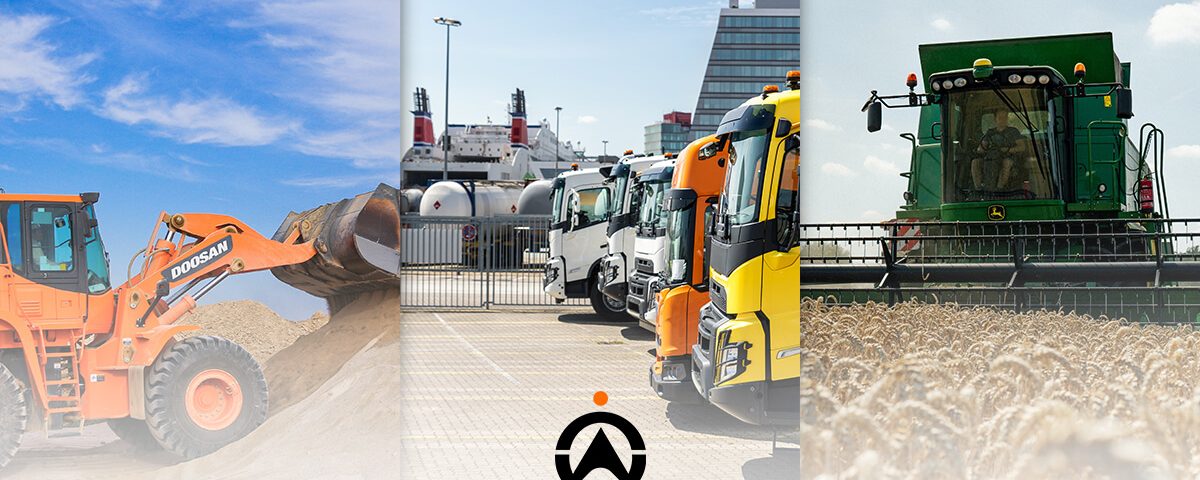Fleet Asset Management – Know the Importance To Make Your Fleet Operations Soar
Late deliveries, time-wasting equipment manhunts, underutilised assets, maintenance downtime delays and endless paperwork – the cost-draining world with no fleet asset management system.
Unravel the importance of fleet asset management software and how it will transform your fleet operations like never before.
What is fleet asset management?
Where ‘asset management’ usually speaks towards wealth and acquired things owned by a person or organisation. Fleet asset management is a method fleet managers use to properly oversee all their business’s assets, ensuring they are all accounted for, in good working condition and are all equally used so they continue to provide a positive return and don’t cost a business more than they should.
This involves monitoring, maintaining, and strategically utilising each vehicle in the fleet. All this is required to enhance operational efficiency, reduce costs, and extend the lifespan of assets.
What is classified as a business asset?
The assets referred to here can be split between tangible assets like physical tools, vehicles, etc and intangible assets, like the software used.
Tangible assets consist of various objects, here are a few types:
Vehicles
- Cars, trucks, vans, buses, motorcycles, etc.
- Trailers, semi-trailers, and other towed equipment
- Construction equipment, such as bulldozers, excavators, and cranes
- Material handling equipment, such as forklifts and pallet jacks
Equipment
- Tools used for maintenance, repairs, and various tasks
- Mobile tech gadgets, like tablets and scanners
- Communication tools, including radios and GPS trackers
- Office equipment, such as computers and printers
Infrastructure
- Garages, workshops, and other facilities like work sites
- Owned storage and fueling stations
- Parking lots and loading docks
- Offices and administrative buildings
Intangible assets are those that don’t have a physical form but still hold significant value for the business:
- Software and technology like the fleet management software used
- Data and analytics acquired from vehicle telematics, fuel card transactions etc.
- Intellectual property (IP) like business trademarks and patents
What is the importance of fleet asset management?
It all begins with your vehicles, equipment, and machinery, the essential assets that keep your business moving forward. Fleet asset management ensures that each vehicle in your fleet operates seamlessly, that your equipment is in top-notch condition, and that your machinery continuously runs smoothly.
Proper management of these assets is not just a task, it’s an important part of driving your fleet to success. Without it, the rhythm of your operations could turn chaotic with breakdowns, delays, increased costs and many other profit-impacting factors.
The benefits of using fleet asset management software
- Supervision of all assets
- Management of assets from any location
- Offers insights for strategic planning for fleet risks
- Improvement of time management
- Monitoring fleet performance
- Tracking fleet asset life cycle and costs acquired

How does fleet asset management differ from general fleet management?
Let’s think of fleet asset management as the guardian overseeing all your valuable resources, and fleet management as the skilled expert handling the specific challenges of your vehicles and machinery.
Asset management looks at the bigger picture, caring for everything from vehicles to machinery and even office tools. It ensures everything is in the right place, performing optimally, and contributing to your overall success.
On the flip side, fleet management focuses on the unique challenges of your vehicles and machinery. It ensures your fleet operates smoothly, tackling issues like maintenance, fuel efficiency, and driver behaviour.
Together, they create a powerful duo for your fleet where one guides the other.
How to set up an asset management plan?
To better manage your assets, you first have to create an asset management plan. Crafting a carefully devised plan for managing your fleet assets can boost productivity and extend the lifespan of your resources. This strategy empowers you to create a more sustainable and effective business model and unlocks the full potential of your assets.
Here’s a simple six-step guide to optimal asset performance:
- First, clearly define your goals for your fleet and make sure they’re specific, measurable, achievable and time-bound. This sets the foundation for your plan.
- Next, take a good look at your current fleet, considering things like types of vehicles, their age, condition, and how they’re used. This assessment helps you find areas for improvement and chances to save money.
- It’s crucial to track your vehicles, equipment, machinery etc. and make a detailed inventory of all of them. For this, use technology like GPS, telematics and the Internet of Things (IoT) to monitor them in real-time.
- Plan regular fleet maintenance to keep your vehicles in good shape and avoid unexpected breakdowns with preventative maintenance. Train your drivers on safety and fuel-efficient driving, and make sure they follow traffic rules.
- Control your operational costs by monitoring fuel usage, maintenance, and fleet costs like speeding tickets and insurance expenses.
- Be prepared for emergencies with contingency plans. Review and update your fleet asset management plan regularly to adapt to changes and improve it over time to fit the current state of your fleet.
Define the types of fleet asset management
To better put it into perspective, there are several types of fleet asset management, including physical asset management, financial asset management, human asset management, and contractual asset management.
Let’s break these down in a bit more detail:
- Physical asset management:
Focuses on overseeing tangible assets like vehicles and equipment to ensure longevity and efficiency.
- Financial asset management:
Involves managing financial instruments such as stocks, bonds, and cash to optimise investment portfolios.
- Human asset management:
Encompasses the administration of human resources, including employees or contractors, and skills within an organisation to enhance workforce performance and development.
What factors contribute to effective fleet asset management?
Effective asset management is the cornerstone of a successful business, encompassing the strategic oversight of your vehicles, equipment, and machinery. This comprehensive approach ensures that these assets are not just operational tools but vital components contributing to the overall success and sustainability of your enterprise.
- Operational efficiency: Skilfully organising and overseeing your vehicles and machinery ensures seamless day-to-day activities. Whether it’s delivery trucks or heavy equipment, a well-structured system minimises downtime and maximises productivity.
- Cost savings: By implementing preventive maintenance schedules, monitoring fuel consumption, and addressing potential issues like risky driver behaviour proactively, you can significantly cut operational expenses.
- Asset longevity: Regular maintenance and timely repairs contribute to the extended lifespan of your assets. This not only safeguards your initial investment but also diminishes the need for frequent replacements, resulting in long-term savings.
- Safety compliance: Asset management involves ensuring compliance with safety regulations. From regular inspections to implementing safety features, adherence to standards protects your assets, employees, and your business’s reputation.
- Data-driven decision-making: Employing technology for asset management yields valuable data insights. Real-time tracking, performance analytics, and predictive maintenance empower you to make informed decisions, enriching your overall business strategy.
- Resource optimisation: Effectively allocate resources by understanding the usage patterns of your assets. Whether deploying vehicles for optimal routes or scheduling maintenance during non-peak hours, resource optimisation enhances operational efficiency.

What is ultimate fleet asset management for your fleet operations?
Cartrack’s industry-leading fleet management software is the perfect fit for any type of business looking to seamlessly manage its assets.
Our comprehensive solution is tailored to meet all your needs and elevate your fleet management to new heights.
Here are five ways Cartrack Swaziland will help you gain full visibility and control of all your assets:
- Proactive maintenance: Say goodbye to unexpected breakdowns and unnecessary downtime. Cartrack’s predictive maintenance anticipates potential issues before they become critical. Through advanced analytics, all equipment data is analysed to predict when servicing is needed and swiftly inform you. For example, predictive maintenance can identify a worn-out part in a forklift and promptly inform you to take precautions with replacements. This prevents costly, unexpected breakdowns, minimises downtime and maximises asset lifespan.
- Fleet management platform: See usage patterns of assets with Cartrack’s fleet management platform and ensure assets are evenly used by remotely scheduling your assets across your project site. With this, you can see which crane or any asset, is being underutilised, and promptly reallocate it to a more active project.
- ID tags: Our driver ID tags help you restrict machinery usage to authorised operators only. This gadget uniquely identifies drivers to fleet managers, allowing them to know which one of their drivers is operating their vehicles/machinery, to ensure only trained and authorised personnel operate equipment and enhance asset security and safety.
- Asset Tracking: Cartrack employs GPS and IoT sensors to get real-time location data and information on equipment conditions. This improves inventory management, enhances security against theft, and aids in preventive maintenance.
- Geofences: Create virtual parameters around your working sites, no-go zones or any other area of interest with our geofencing technology. Alerts are sent to you whenever assets enter or exit digitally set boundaries. This prevents potential theft and helps you monitor vehicle activity.
Turn your assets into profit-boosting machines with Cartrack Swaziland
Gain complete control and visibility over every vehicle, equipment, and machinery in your fleet. Choose Cartrack for fleet asset management and experience a new era of efficiency, cost savings, and peace of mind.
Start today with Cartrack Swaziland.


